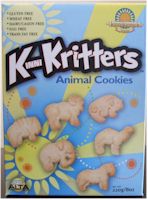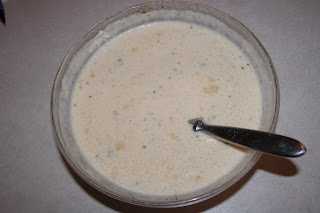It was overwhelming for me, at first, to put Barrett on a gluten-free diet. What would he eat for nursery snacks at church? How could I feed him while we were traveling? How would I get him enough calories? How much would it cost? Where do I even find gluten-free foods? But I learned that after I found a system things would fall into place and it would not be stressful for me.
There are many places to find gluten-free products. Most health food stores will have at least a small selection. Many grocery stores like Smith's and Macey's have organic sections or special shelves marked as "organic" that often have gluten-free foods. Sunflower Market also has gluten-free products that are specially marked.
For nursery I put gluten-free cereal, raisins, craisins, fruit snacks, and crackers in zip-lock bags and put them in a container. I explained the situation to all the nursery workers and they now keep his snacks in the closet so I don't have to worry about bringing something for him every week.
One thing I really struggled with was finding foods that I could give my son quickly. A friend told me that she makes gluten-free cornbread muffins and freezes them, then puts peanut butter on top and send them to school with her son for lunch. I thought it was a great idea, and although I learned that my son can't have corn I like to make zucchini and pumpkin bread muffins and keep them in the freezer. Then I just thaw them out in the microwave for 40 seconds on defrost and give them to Barrett. If I am travelling I put one or two in a ziplock bag and bring it in the car.
Many people make their whole house gluten-free when a member of the family goes on the diet. We chose not to do that because it is very expensive and my son has to avoid so many things it would be very difficult to have us all do it. We may try it if it becomes necessary, but so far Barrett just accepts that he eats different food than everyone else and does not have a problem with it. When I cook dinner I try to make it gluten-free if I can do it easily, otherwise I just cook something different for Barrett. When I make pasta I make the sauce gluten-free and then use rice noodles for Barrett and regluar noodles for the rest of the family. I thicken chile and soups with gluten-free flour (you can also use corn starch but I avoid that because of his possible corn intolerance).
There are many gluten free flours you can choose from for baking. You can buy premade pancake mixes, cake and cookie mixes, breadstick and pizza crust mixes and more. They are expensive but they tend to taste better than a lot of homemade ones. I however, prefer to make my own. You can read about different kinds of flour and how they work on the internet. Experiment with them and when you find a combination you like you can make your own pancake mixes and cake mixes and store them in large zip-lock bags or tupperware containers. It's a lot of work at first but in the long run it is cheaper and will save you time. Usually it's best to combine different types of flours so the flavor of one does not overpower your food. You also need to add a starch to it or the flour will not hold together very well. The standard mixture is:
2/3 part potato starch
1/3 part tapioca starch
2 parts flour of your choice
1 tsp xanthan or guar gum (I use guar because xanthan gum is derived from corn)
I usually throw the ingredients in a large ziplock bag and shake them up. Then I date and label them. Some flours need to be stored in the fridge so read the labels.
The noodles I have found to be the best are
Tinkyada brand noodles. They are made from rice, taste good and they don't fall apart. Even the lasagna noodles work well. I also like Ancient Harvest
Quinoa and Corn noodles, but they fall apart more easily if they are overcooked.
For breakfast you can usually find hot cereals like
quinoa flakes,
buckwheat cereal (not related to wheat), hot
rice cereal, and gluten free oats for oatmeal (make sure the oats are specially marked gluten-free. Red Mill sells some
gluten-free oats but they are expensive). Regular brand cereals that are currently gluten free (but always check the label because they change the recipe sometimes) are Rice Chex, Fruity Pebbles, Trix, and Dora and Diego cereals. I also like to buy
Erewon Crispy Rice and some no-name brand called Cinnamon O's. (Basically just a plain box with plain black print I found in the gluten-free section at Macey's).
You have several options for flour. The best, if you are not avoiding milk, is
Pamela's Pancake and Baking Mix. It is a little light though and if you want something heavier just mix it with another flour.
Bob's gluten-free baking mix is a pre-made mix made out of garbanzo and fava bean flours. It's alright but I never use that alone because the bean flavor is a little strong. The cheapest is rice flour. You can even get a grain grinder and grind your own to make it even cheaper. I can't stand the taste of rice flour though (brown rice is better than white rice in my opinion). Sweet rice flour isn't bad and is good for pie shells, but it is a lot more expensive. You can get it in Asian stores and it's usually called Mochika. I like to use buckwheat flour for sweet things like pancakes, cakes, and sweet breads (but never alone--mix it with another kind of flour). Soy flour works well if you do not have problems with soy. You can also use millet flour, garbanzo bean flour, fava bean flour, sorhgum flour, coconut flour, and potato flour (different from potato starch). Millet flour is better for pizza crust-type foods. I use coconut flour to absorb extra liquids. It is probably a good one to mix with the Pamela's mix. I will be posting recipes that I have tried and adapted on this blog soon.





.jpg)










 Doesn't that look wonderful? The crust was. Too bad the rest totally didn't work. I think I failed on the egg-replacer part of it.
Doesn't that look wonderful? The crust was. Too bad the rest totally didn't work. I think I failed on the egg-replacer part of it.















